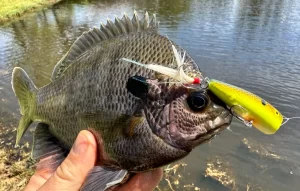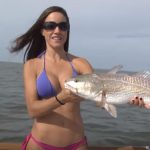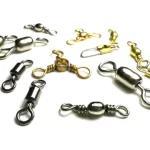A good topwater smash is one of the greatest thrills in fishing. While dozens of surface lures exist, few are as iconic and user-friendly as a popper. Available in various colors and sizes, poppers share a common design — a scooped, concave mouth that grabs water when twitched, creating a splash and commotion that attracts predatory fish.
The classic pop-and-pause technique remains effective, but relying solely on this method may limit success. Here are four alternative ways to fish a popper that can increase versatility and trigger more aggressive strikes.

The Speed Reel
Poppers are often treated as finesse lures with a slow, deliberate cadence. However, ramping up the speed can yield surprising results, especially in freshwater. Tuna anglers frequently rip large poppers across saltwater surfaces to provoke violent strikes. A similar technique can work wonders for bass.
Legendary angler Rick Clunn famously won tournaments in the early ‘80s using a high-speed retrieve with a Rebel Pop-R. The key is mimicking the erratic movements of a panicked baitfish. By casting a popper and quickly reeling it back without pausing, the lure’s scooped mouth will still displace water and generate noise. The rapid motion can provoke predatory instincts in bass, resulting in aggressive hits.
The Bug Shake
For a more subtle approach, consider the “bug shake.” This method is especially effective when using a popper with a dressed tail, typically featuring synthetic fibers or feathers. If a popper doesn’t have a dressed tail, adding one using super glue, thread, and feathers from a craft store is an easy DIY fix.
When resting on the water, a popper’s tail hook can resemble a struggling aquatic insect. During a bug hatch, fish often focus on these easy meals. A gentle twitch that makes the tail hook quiver can mimic a drowning bug, drawing cautious bites from bass, bluegill, or even trout. Watch closely for the popper to vanish or for subtle surface disturbances.
The Up-And-Down
Inspired by the saltwater popping cork technique, this trick adds extra action below the surface. Begin by removing the rear treble hook from the popper. Then, tie a short leader (around 12 inches) to the rear ring and attach a small soft-plastic bait or grub.
As the popper splashes and creates noise on the surface, the trailing lure will dart below like an injured baitfish. This dual-action presentation is particularly effective for schooling species like white bass or striped bass. The splash calls them in, while the submerged bait seals the deal.
Fish the Edges
Targeting predatory fish like bass often means working along structure. Bass are ambush predators, favoring docks, seawalls, and submerged logs where they can strike unsuspecting prey.
Casting a popper parallel to a dock keeps the lure in the strike zone for longer periods. Each chug tempts fish lurking beneath shaded areas. Stay alert — bass often strike fast and hard before retreating to cover. Maintaining control and applying steady pressure will help keep the fish out of entanglements.
Poppers offer exceptional versatility. Whether chugging slowly, speeding across the surface, or barely twitching to imitate struggling prey, the key is experimenting to find what triggers bites on any given day. Poppers come in various sizes and colors, with different cup shapes designed to move varying amounts of water.
Adapting techniques to suit water conditions and fish behavior can lead to explosive topwater action. Stay observant and adjust the retrieve until fish show their preference. A popper is a must-have lure for anglers looking to maximize their time on the water this spring and summer.
Image/Source: OL





